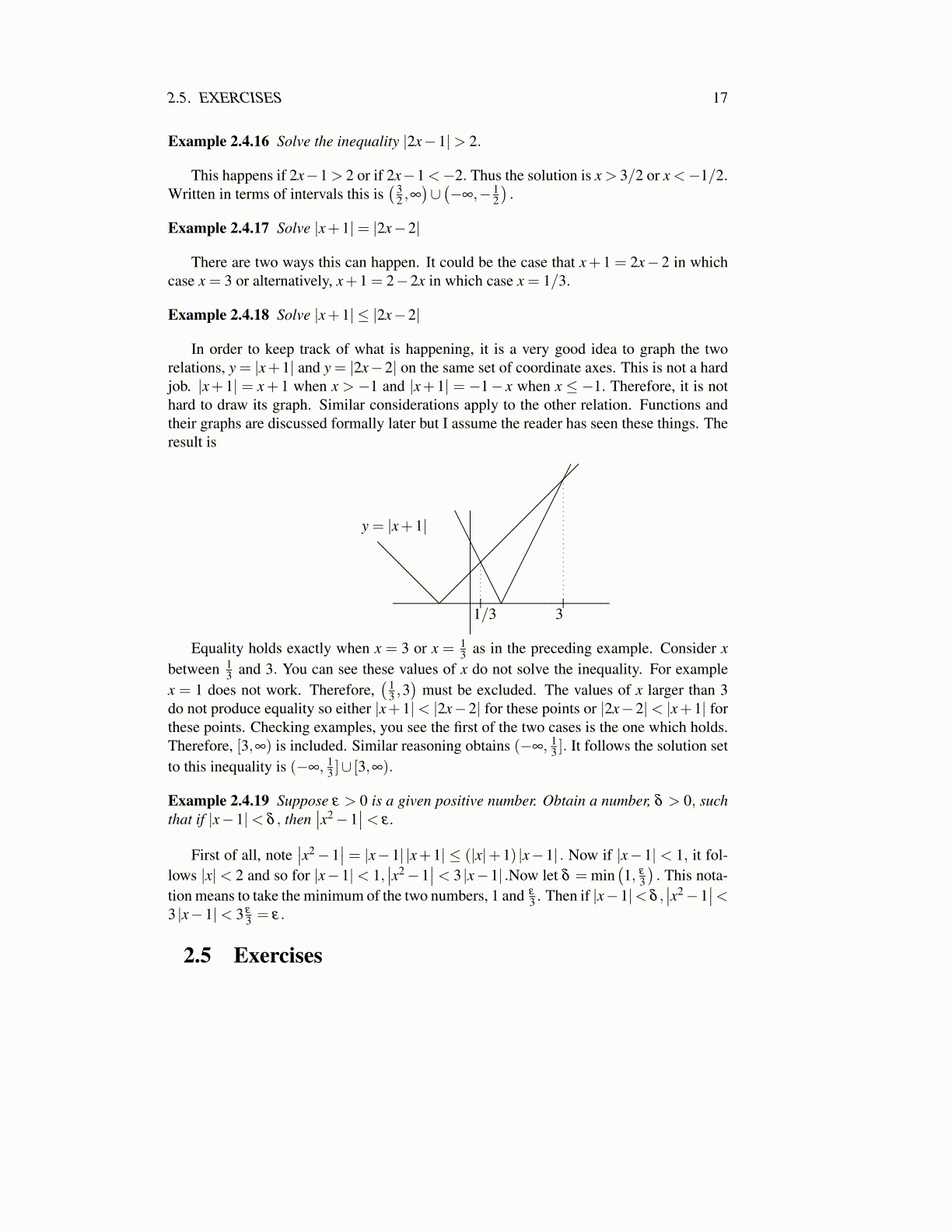
2.5. EXERCISES 17
Example 2.4.16 Solve the inequality |2x−1|> 2.
This happens if 2x−1 > 2 or if 2x−1 <−2. Thus the solution is x > 3/2 or x <−1/2.Written in terms of intervals this is
( 32 ,∞
)∪(−∞,− 1
2
).
Example 2.4.17 Solve |x+1|= |2x−2|
There are two ways this can happen. It could be the case that x+1 = 2x−2 in whichcase x = 3 or alternatively, x+1 = 2−2x in which case x = 1/3.
Example 2.4.18 Solve |x+1| ≤ |2x−2|
In order to keep track of what is happening, it is a very good idea to graph the tworelations, y = |x+1| and y = |2x−2| on the same set of coordinate axes. This is not a hardjob. |x+1| = x+ 1 when x > −1 and |x+1| = −1− x when x ≤ −1. Therefore, it is nothard to draw its graph. Similar considerations apply to the other relation. Functions andtheir graphs are discussed formally later but I assume the reader has seen these things. Theresult is
13 3
y = |x+1|
Equality holds exactly when x = 3 or x = 13 as in the preceding example. Consider x
between 13 and 3. You can see these values of x do not solve the inequality. For example
x = 1 does not work. Therefore,( 1
3 ,3)
must be excluded. The values of x larger than 3do not produce equality so either |x+1|< |2x−2| for these points or |2x−2|< |x+1| forthese points. Checking examples, you see the first of the two cases is the one which holds.Therefore, [3,∞) is included. Similar reasoning obtains (−∞, 1
3 ]. It follows the solution setto this inequality is (−∞, 1
3 ]∪ [3,∞).
Example 2.4.19 Suppose ε > 0 is a given positive number. Obtain a number, δ > 0, suchthat if |x−1|< δ , then
∣∣x2−1∣∣< ε .
First of all, note∣∣x2−1
∣∣ = |x−1| |x+1| ≤ (|x|+1) |x−1| . Now if |x−1| < 1, it fol-lows |x|< 2 and so for |x−1|< 1,
∣∣x2−1∣∣< 3 |x−1| .Now let δ = min
(1, ε
3
). This nota-
tion means to take the minimum of the two numbers, 1 and ε
3 . Then if |x−1|< δ ,∣∣x2−1
∣∣<3 |x−1|< 3 ε
3 = ε.
2.5 Exercises
1. Solve (3x+2)(x−3)≤ 0.
2. Solve (3x+2)(x−3)> 0.
3. Solve x+23x−2 < 0.
4. Solve x+1x+3 < 1.
5. Solve (x−1)(2x+1)≤ 2.
6. Solve (x−1)(2x+1)> 2.
7. Solve x2−2x≤ 0.
8. Solve (x+2)(x−2)2 ≤ 0.
9. Solve 3x−4x2+2x+2 ≥ 0.